Multi-Objective Optimal Design of Renewable Energy Integrated CCHP System Using PICEA-g
Abstract
:1. Introduction
2. System Model of CCHP System with Renewable Energies in Isolated Mode
2.1. Traditional Energy System
2.2. Structure of RECCHP System
2.3. Component Model
2.3.1. PV Panel
2.3.2. Wind Turbine
2.3.3. Renewable Energy Generation
2.3.4. Battery
2.3.5. Heat Storage Tank
2.3.6. Power Generation Unit
2.4. Operation Strategy
2.4.1. FEL Operation Strategy
2.4.2. FTL Operation Strategy
| Algorithm 1: Flowchart of FTL |
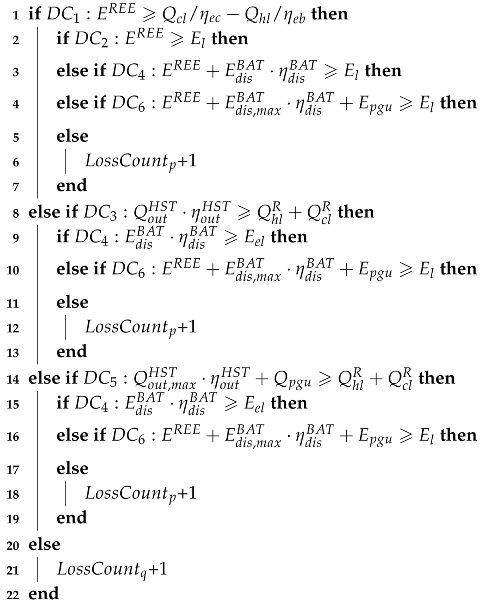 |
3. RECCHP System Optimization Model Using PICEA-g
3.1. Overview of PICEA-g
3.2. Optimization Objectives
3.2.1. Annual Total Cost
- The annual operating and maintenance cost can be written as:
- The annual fuel cost is described as:
- The initial investment cost can be written as:with:
3.2.2. Carbon Dioxide Emission
3.2.3. Loss of Energy Supply Probability
3.3. System Simulation and Optimization Model
4. Case Study and Result Analysis
4.1. Case Study
4.1.1. Input Data
4.1.2. Parameters
4.2. Results and Discussion
- A reliable RECCHP system should have a low LESP value, which is preferably 0. Three solutions with LESP less than 0.1% for the FEL and FTL strategies are shown in Table 5.
- Furthermore, if the decision-maker is more concerned about the system cost, the solution with the smallest ATC should be chosen. Likewise, solutions with the minimum CDE are more likely to be selected if the fuel usage and CO2 emission are considered as more important for the decision-maker.
- Comparing the fuel consumption of PGU under FEL and FTL strategies, it is obvious that the fuel consumption in FEL is large in summer and winter while small in spring and autumn. In addition, the difference for FTL in different seasons is as evident as that for the FEL.
- Regarding the FEL strategy, we can observe from Figure 12c,d that the battery has a large capacity while the capacity of HST is small and sometimes even reaches 0.
- Regarding the FTL strategy, we can observe from Figure 13c,d that the capacity of the battery is small while HST has great capacity. Obviously, in spring and autumn, HST is only slightly used. The reason may be that the thermal demand in these seasons is pretty small, which can be directly met by renewable energy generation. Hence, some thermal energy generated from PGU may be wasted.
5. Conclusions
Acknowledgments
Author Contributions
Conflicts of Interest
Abbreviations
| ATC | annual total cost |
| CCHP | combined cooling, heating, and power |
| CDE | carbon dioxide emission |
| CRF | capital recovery factor |
| DC | discriminant condition |
| FF | fill factor |
| HST | heat storage tank |
| MOEA | multi-objective evolutionary algorithm |
| NCOT | nominal cell operating temperature |
| PGU | power generation unit |
| RECCHP | renewable energies integrated CCHP |
| LESP | loss of energy supply probability |
| LNG | liquid natural gas |
| SOC | battery state of charge |
| Superscripts | |
| BAT | battery |
| CCHP | combined cooling, heating, and power |
| FEL | following electric load |
| FTL | following the thermal load |
| R | the remaining user load after renewable energies supply |
| REE | renewable energies |
| S | storage devices |
| HST | heat storage tank |
| STC | standard test condition |
| Subscripts | |
| ac | absorption chiller |
| bat | battery |
| c | cool |
| cap | capital |
| CO2 | carbon dioxide |
| cl | cold load |
| ch | charge |
| dis | discharge |
| e | electricity |
| eb | electric boiler |
| ec | electric chiller |
| el | electrical load |
| h | heat |
| hc | heating coil |
| hl | heat load |
| in | input |
| max | maximum |
| min | minimum |
| oc | open-circuit |
| out | output |
| pgu | power generation unit |
| pv | photovoltaic |
| r | waste heat recovery system |
| rep | replace |
| sc | short-circuit |
| st | heat storage tank |
| tow | wind turbine tower |
| wt | wind turbine |
| Symbols | |
| C | cost |
| Cap | capital |
| COP | coefficient of performance |
| E | electric power |
| F | fuel |
| I | current |
| Q | thermal power |
| U | operation status of battery |
| V | operation status of heat storage tank/voltage |
| η | energy efficiency |
References
- Liu, M.X.; Shi, Y.; Fang, F. Combined cooling, heating and power systems: A survey. Renew. Sustain. Energy Rev. 2014, 35, 1–22. [Google Scholar] [CrossRef]
- Gu, W.; Wu, Z.; Bo, R.; Liu, W.; Zhou, G.; Chen, W.; Wu, Z.J. Modeling, planning and optimal energy management of combined cooling, heating and power microgrid: A review. Int. J. Electr. Power Energy Syst. 2014, 54, 26–37. [Google Scholar] [CrossRef]
- Cho, H.; Smith, A.D.; Mago, P. Combined cooling, heating and power: A review of performance improvement and optimization. Appl. Energy 2014, 136, 168–185. [Google Scholar] [CrossRef]
- Cho, H.; Mago, P.J.; Luck, R.; Chamra, L.M. Evaluation of CCHP systems performance based on operational cost, primary energy consumption, and carbon dioxide emission by utilizing an optimal operation scheme. Appl. Energy 2009, 86, 2540–2549. [Google Scholar] [CrossRef]
- Wang, H.; Yin, W.; Abdollahi, E.; Lahdelma, R.; Jiao, W. Modelling and optimization of CHP based district heating system with renewable energy production and energy storage. Appl. Energy 2015, 159, 401–421. [Google Scholar] [CrossRef]
- Wang, L.; Singh, C. Stochastic combined heat and power dispatch based on multi-objective particle swarm optimization. Int. J. Electr. Power Energy Syst. 2008, 30, 226–234. [Google Scholar] [CrossRef]
- Cho, H.; Luck, R.; Eksioglu, S.D.; Chamra, L.M. Cost-optimized real-time operation of CHP systems. Energy Build. 2009, 41, 445–451. [Google Scholar] [CrossRef]
- Sadat Hosseini, S.S.; Jafarnejad, A.; Behrooz, A.H.; Gandomi, A.H. Combined heat and power economic dispatch by mesh adaptive direct search algorithm. Expert Syst. Appl. 2011, 38, 6556–6564. [Google Scholar] [CrossRef]
- Sevencan, S.; Lindbergh, G.; Lagergren, C.; Alvfors, P. Economic feasibility study of a fuel cell-based combined cooling, heating and power system for a data centre. Energy Build. 2016, 111, 218–223. [Google Scholar] [CrossRef]
- Xu, Y.; Li, W.; Yuan, J.; Sciubba, E. Economical Efficiency of Combined Cooling Heating and Power Systems Based on an Enthalpy Method. Energies 2017, 10, 1821. [Google Scholar] [CrossRef]
- Mago, P.J.; Chamra, L.M. Analysis and optimization of CCHP systems based on energy, economical, and environmental considerations. Energy Build. 2009, 41, 1099–1106. [Google Scholar] [CrossRef]
- Wu, J.; Wang, J.; Li, S. Multi-objective optimal operation strategy study of micro-CCHP system. Energy 2012, 48, 472–483. [Google Scholar] [CrossRef]
- Xu, D.; Qu, M. Energy, environmental, and economic evaluation of a CCHP system for a data center based on operational data. Energy Build. 2013, 67, 176–186. [Google Scholar] [CrossRef]
- Wei, D.J.; Chen, A.; Sun, B.; Zhang, C.H. Multi-objective optimal operation and energy coupling analysis of combined cooling and heating system. Energy 2016, 98, 296–307. [Google Scholar] [CrossRef]
- Yousefi, H.; Ghodusinejad, M.H.; Noorollahi, Y. GA/AHP-based optimal design of a hybrid CCHP system considering economy, energy and emission. Energy Build. 2017, 138, 309–317. [Google Scholar] [CrossRef]
- Lahdelma, R.; Hakonen, H. An efficient linear programming algorithm for combined heat and power production. Eur. J. Oper. Res. 2003, 148, 141–151. [Google Scholar] [CrossRef]
- Rong, A.; Hakonen, H.; Lahdelma, R. An efficient linear model and optimisation algorithm for multi-site combined heat and power production. Eur. J. Oper. Res. 2006, 168, 612–632. [Google Scholar] [CrossRef]
- Rong, A.; Lahdelma, R. An effective heuristic for combined heat-and-power production planning with power ramp constraints. Appl. Energy 2007, 84, 307–325. [Google Scholar] [CrossRef]
- Hussain, A.; Bui, V.H.; Kim, H.M.; Im, Y.H.; Lee, J.Y. Optimal Energy Management of Combined Cooling, Heat and Power in Different Demand Type Buildings Considering Seasonal Demand Variations. Energies 2017, 10, 789. [Google Scholar] [CrossRef]
- Qin, C.; Tang, J.; Zhang, Y. An efficient algorithm for CCHP system sizing and an operational optimization model based on LP. J. Nat. Gas Sci. Eng. 2015, 25, 189–196. [Google Scholar] [CrossRef]
- Li, G.Q.; Zhang, R.F.; Jiang, T.; Chen, H.H.; Bai, L.Q.; Cui, H.T.; Li, X.J. Optimal dispatch strategy for integrated energy systems with CCHP and wind power. Appl. Energy 2017, 192, 408–419. [Google Scholar] [CrossRef]
- Carvalho, M.; Serra, L.M.; Lozano, M.A. Optimal synthesis of trigeneration systems subject to environmental constraints. Energy 2011, 36, 3779–3790. [Google Scholar] [CrossRef]
- Lozano, M.A.; Ramos, J.C.; Serra, L.M. Cost optimization of the design of CHCP (combined heat, cooling and power) systems under legal constraints. Energy 2010, 35, 794–805. [Google Scholar] [CrossRef]
- Gopisetty, S.; Treffinger, P. Generic Combined Heat and Power (CHP) Model for the Concept Phase of Energy Planning Process. Energies 2016, 10, 11. [Google Scholar] [CrossRef]
- Wang, J.J.; Zhai, Z.Q.; Jing, Y.Y.; Zhang, C.F. Particle swarm optimization for redundant building cooling heating and power system. Appl. Energy 2010, 87, 3668–3679. [Google Scholar] [CrossRef]
- Fu, X.; Huang, S.; Li, R.; Sun, H. Electric Power Output Optimization for CCHP Using PSO Theory. Energy Procedia 2016, 103, 9–14. [Google Scholar] [CrossRef]
- Subbaraj, P.; Rengaraj, R.; Salivahanan, S. Enhancement of combined heat and power economic dispatch using self adaptive real-coded genetic algorithm. Appl. Energy 2009, 86, 915–921. [Google Scholar] [CrossRef]
- Wang, J.J.; Jing, Y.Y.; Zhang, C.F. Optimization of capacity and operation for CCHP system by genetic algorithm. Appl. Energy 2010, 87, 1325–1335. [Google Scholar] [CrossRef]
- Li, M.; Mu, H.; Li, H. Analysis and Assessments of Combined Cooling, Heating and Power Systems in Various Operation Modes for a Building in China, Dalian. Energies 2013, 6, 2446–2467. [Google Scholar] [CrossRef]
- Gimelli, A.; Muccillo, M. Optimization criteria for cogeneration systems: Multi-objective approach and application in an hospital facility. Appl. Energy 2013, 104, 910–923. [Google Scholar] [CrossRef]
- Muccillo, M.; Gimelli, A.; Sannino, R. Multi-objective Optimization and Sensitivity Analysis of a Cogeneration System for a Hospital Facility. Energy Procedia 2015, 81, 585–596. [Google Scholar] [CrossRef]
- Alvarado, D.C.; Acha, S.; Shah, N.; Markides, C.N. A Technology Selection and Operation (TSO) optimisation model for distributed energy systems: Mathematical formulation and case study. Appl. Energy 2016, 180, 491–503. [Google Scholar] [CrossRef]
- Wang, F.; Zhou, L.; Ren, H.; Liu, X. Search Improvement Process-Chaotic Optimization-Particle Swarm Optimization-Elite Retention Strategy and Improved Combined Cooling-Heating-Power Strategy Based Two-Time Scale Multi-Objective Optimization Model for Stand-Alone Microgrid Operation. Energies 2017, 10, 1936. [Google Scholar] [CrossRef]
- Gimelli, A.; Muccillo, M.; Sannino, R. Optimal design of modular cogeneration plants for hospital facilities and robustness evaluation of the results. Energy Convers. Manag. 2017, 134, 20–31. [Google Scholar] [CrossRef]
- Soheyli, S.; Mayam, M.H.S.; Mehrjoo, M. Modeling a novel CCHP system including solar and wind renewable energy resources and sizing by a CC-MOPSO algorithm. Appl. Energy 2016, 184, 375–395. [Google Scholar] [CrossRef]
- Wu, F.; Guo, Q.; Sun, H.; Pan, Z. Research on the optimization of combined heat and power microgrids with renewable energy. In Proceedings of the 2014 IEEE PES Asia-Pacific Power and Energy Engineering Conference (APPEEC), Hong Kong, China, 7–10 December 2014; IEEE: New York, NY, USA, 2014; pp. 1–5. [Google Scholar]
- Arsalis, A.; Alexandrou, A.N.; Georghiou, G.E. Thermoeconomic Modeling and Parametric Study of a Photovoltaic-Assisted 1 MWe Combined Cooling, Heating, and Power System. Energies 2016, 9, 663. [Google Scholar] [CrossRef]
- Marrasso, E.; Sasso, M.; Tariello, F. Analysis of a Hybrid Solar-Assisted Trigeneration System. Energies 2016, 9, 705. [Google Scholar] [CrossRef]
- Bellos, E.; Tzivanidis, C. Optimization of a Solar-Driven Trigeneration System with Nanofluid-Based Parabolic Trough Collectors. Energies 2017, 10, 848. [Google Scholar]
- Acevedo, L.; Uche, J.; Almo, A.D.; Círez, F.; Usón, S.; Martínez, A.; Guedea, I. Dynamic Simulation of a Trigeneration Scheme for Domestic Purposes Based on Hybrid Techniques. Energies 2016, 9, 1013. [Google Scholar] [CrossRef]
- Kang, E.C.; Lee, E.J.; Ghorab, M.; Yang, L.; Entchev, E.; Lee, K.S.; Lyu, N.J. Investigation of Energy and Environmental Potentials of a Renewable Trigeneration System in a Residential Application. Energies 2016, 9, 760. [Google Scholar] [CrossRef]
- Rey, G.; Ulloa, C.; Míguez, J.L.; Cacabelos, A. Suitability Assessment of an ICE-Based Micro-CCHP Unit in Different Spanish Climatic Zones: Application of an Experimental Model in Transient Simulation. Energies 2016, 9, 969. [Google Scholar] [CrossRef]
- Wang, J.J.; Zhang, C.F.; Jing, Y.Y. Multi-criteria analysis of combined cooling, heating and power systems in different climate zones in China. Appl. Energy 2010, 87, 1247–1259. [Google Scholar]
- Jing, Y.Y.; Bai, H.; Wang, J.J.; Liu, L. Life cycle assessment of a solar combined cooling heating and power system in different operation strategies. Appl. Energy 2012, 92, 843–853. [Google Scholar] [CrossRef]
- Wang, J.J.; Yang, Y.; Mao, T.Z.; Sui, J.; Jin, H.G. Life cycle assessment (LCA) optimization of solar-assisted hybrid CCHP system. Appl. Energy 2015, 146, 38–52. [Google Scholar] [CrossRef]
- Wang, R.; Purshouse, R.C.; Fleming, P.J. Preference-inspired Co-evolutionary Algorithms for Many-objective Optimisation. IEEE Trans. Evol. Comput. 2013, 17, 474–494. [Google Scholar] [CrossRef]
- Barbieri, E.S.; Melino, F.; Morini, M. Influence of the thermal energy storage on the profitability of micro-CHP systems for residential building applications. Appl. Energy 2012, 97, 714–722. [Google Scholar] [CrossRef]
- Ming, M.; Wang, R.; Zha, Y.; Zhang, T. Multi-Objective Optimization of Hybrid Renewable Energy System Using an Enhanced Multi-Objective Evolutionary Algorithm. Energies 2017, 10, 674. [Google Scholar]
- Abedi, S.; Alimardani, A.; Gharehpetian, G.B.; Riahy, G.H.; Hosseinian, S.H. A comprehensive method for optimal power management and design of hybrid RES-based autonomous energy systems. Renew. Sustain. Energy Rev. 2012, 16, 1577–1587. [Google Scholar] [CrossRef]
- Shi, Z.; Wang, R.; Zhang, T. Multi-objective optimal design of hybrid renewable energy systems using preference-inspired coevolutionary approach. Sol. Energy 2015, 118, 96–106. [Google Scholar] [CrossRef]
- Koutroulis, E.; Kolokotsa, D.; Potirakis, A.; Kalaitzakis, K. Methodology for optimal sizing of stand-alone photovoltaic/wind-generator systems using genetic algorithms. Sol. Energy 2006, 80, 1072–1088. [Google Scholar] [CrossRef]
- Yang, H.; Lu, L.; Zhou, W. A novel optimization sizing model for hybrid solar-wind power generation system. Sol. Energy 2007, 81, 76–84. [Google Scholar] [CrossRef]
- Wang, R.; Xiong, J.; Ishibuchi, H.; Wu, G.; Zhang, T. On the effect of reference point in MOEA/D for multi-objective optimization. Appl. Soft Comput. 2016, in press. [Google Scholar] [CrossRef]
- Wang, R.; Zhou, Z.; Liao, T.; Zhang, T. Localized weighted sum method for many-objective optimization. IEEE Trans. Evol. Comput. 2016, 22, 3–18. [Google Scholar] [CrossRef]
- Wang, R.; Zhang, Q.; Zhang, T. Decomposition based algorithms using Pareto adaptive scalarizing methods. IEEE Trans. Evol. Comput. 2016, 20, 821–837. [Google Scholar] [CrossRef]
- Lei, H.; Wang, R.; Laporte, G. Solving a multi-objective dynamic stochastic districting and routing problem with a co-evolutionary algorithm. Comput. Oper. Res. 2016, 67, 12–24. [Google Scholar] [CrossRef]
- Lei, H.; Wang, R.; Zhang, T.; Liu, Y.; Zha, Y. A multi-objective co-evolutionary algorithm for energy-efficient scheduling on a green data center. Comput. Oper. Res. 2016, 75, 103–117. [Google Scholar] [CrossRef]
- Wang, R.; Purshouse, R.C.; Fleming, P.J. Preference-inspired co-evolutionary algorithms using weight vectors. Eur. J. Oper. Res. 2015, 243, 423–441. [Google Scholar] [CrossRef]
- Wang, R.; Purshouse, R.C.; Giagkiozis, I.; Fleming, P.J. The iPICEA-g: A new hybrid evolutionary multi-criteria decision making approach using the brushing technique. Eur. J. Oper. Res. 2015, 243, 442–453. [Google Scholar] [CrossRef]
- Cozzolino, R. Thermodynamic Performance Assessment of a Novel Micro-CCHP System Based on a Low Temperature PEMFC Power Unit and a Half-Effect Li/Br Absorption Chiller. Energies 2018, 11, 315. [Google Scholar] [CrossRef]
- Li, M.; Mu, H.; Li, N.; Ma, B. Optimal design and operation strategy for integrated evaluation of CCHP (combined cooling heating and power) system. Energy 2016, 99, 202–220. [Google Scholar] [CrossRef]
- Fang, F.; Wang, Q.H.; Shi, Y. A Novel Optimal Operational Strategy for the CCHP System Based on Two Operating Modes. IEEE Trans. Power Syst. 2012, 27, 1032–1041. [Google Scholar] [CrossRef]

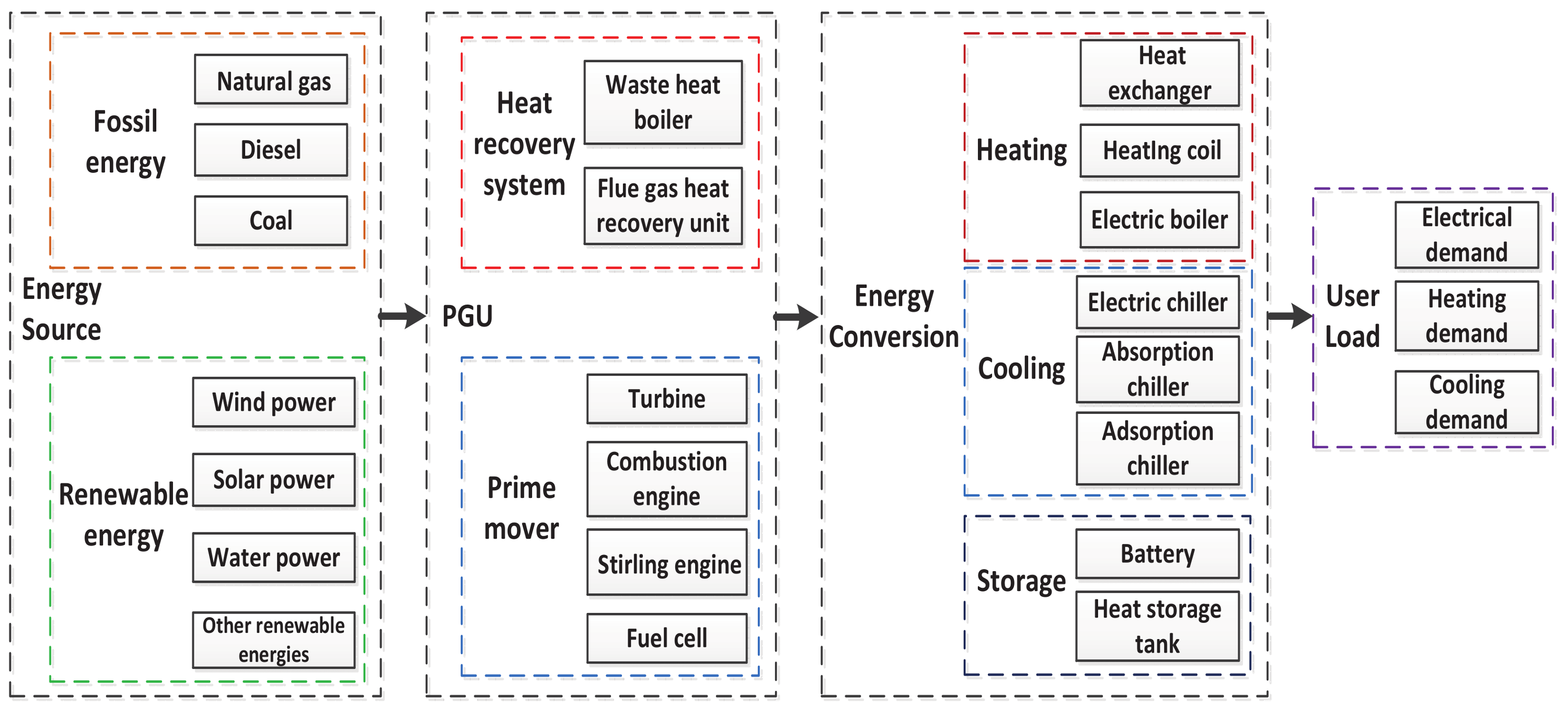
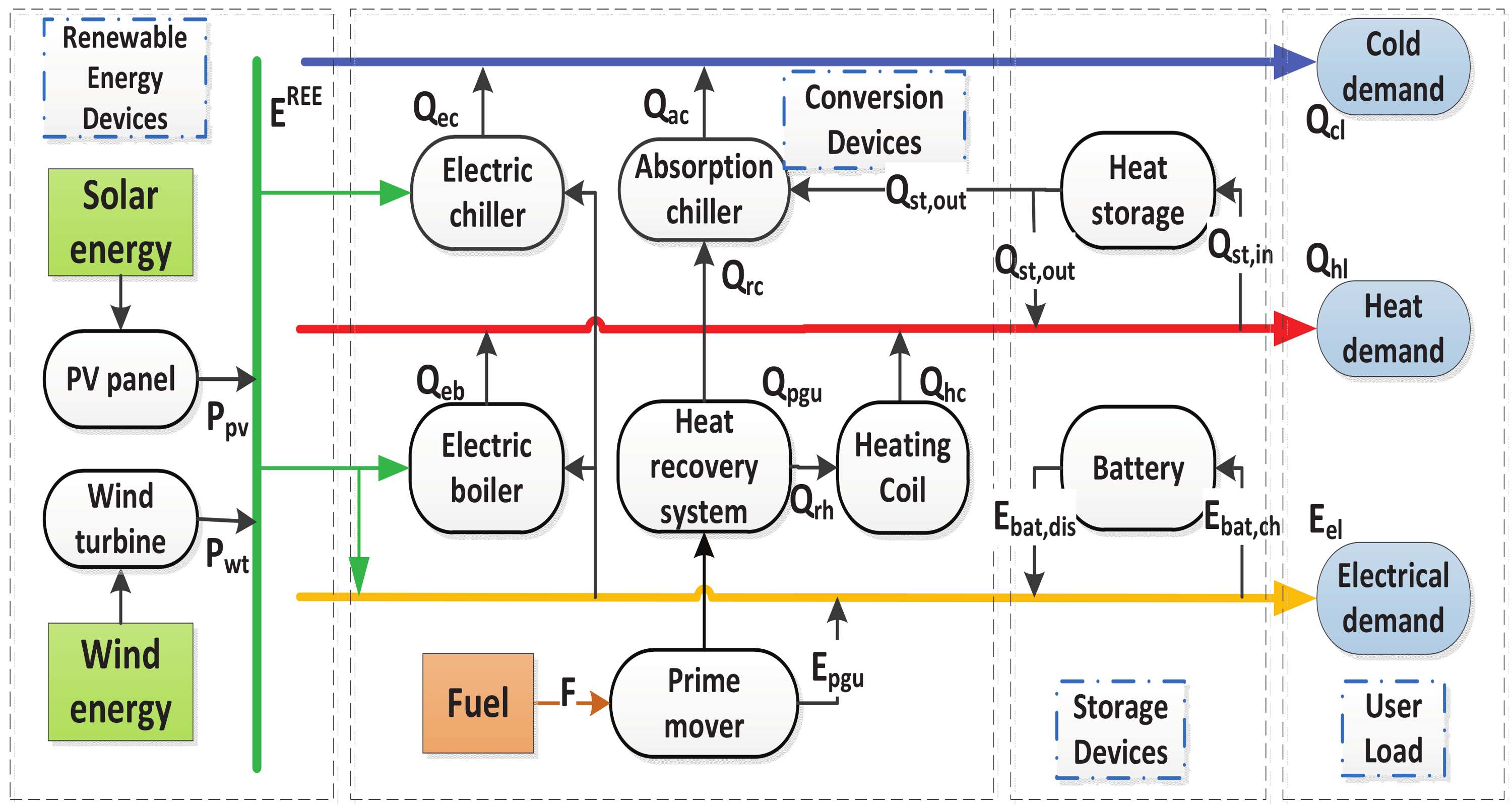
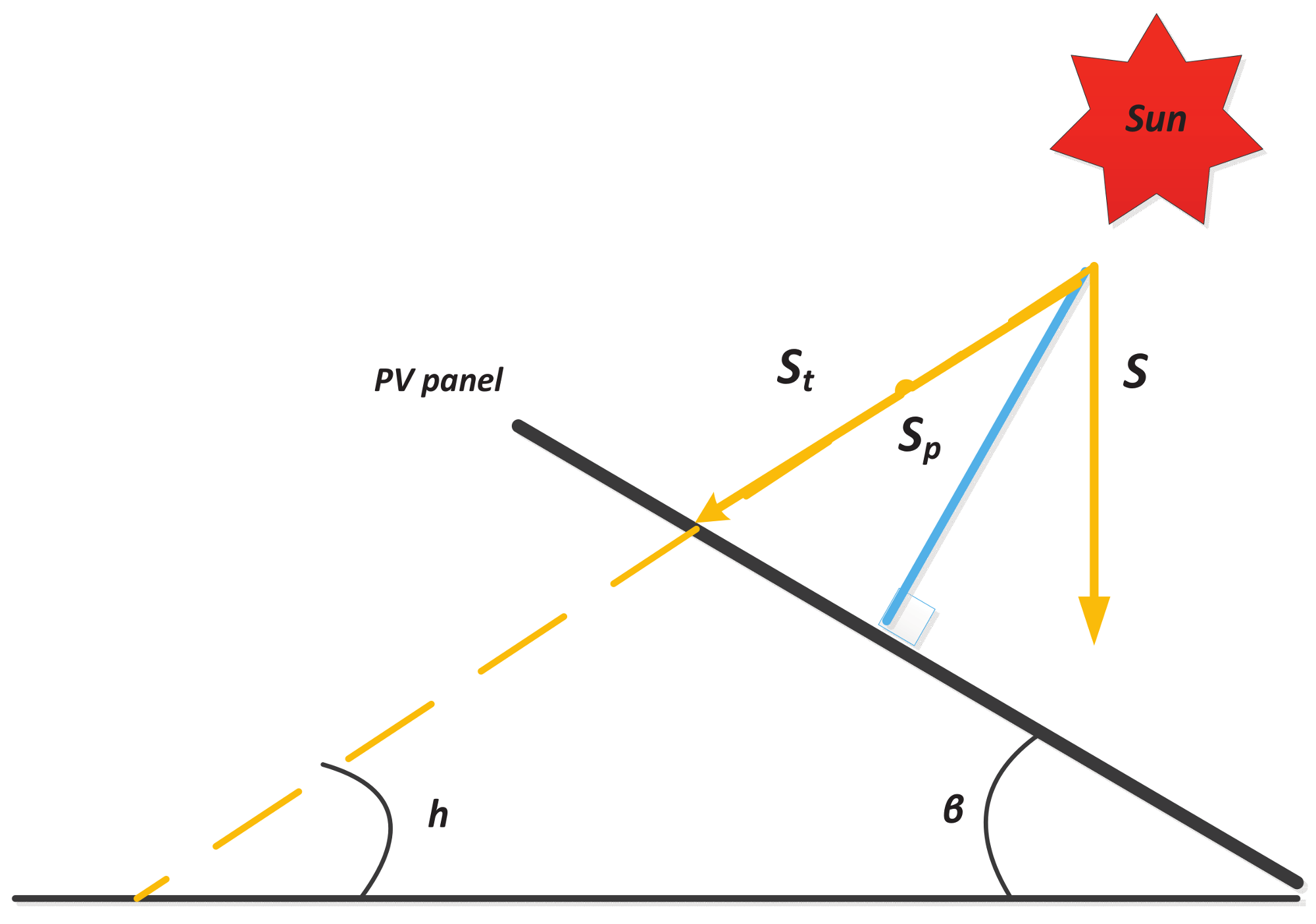
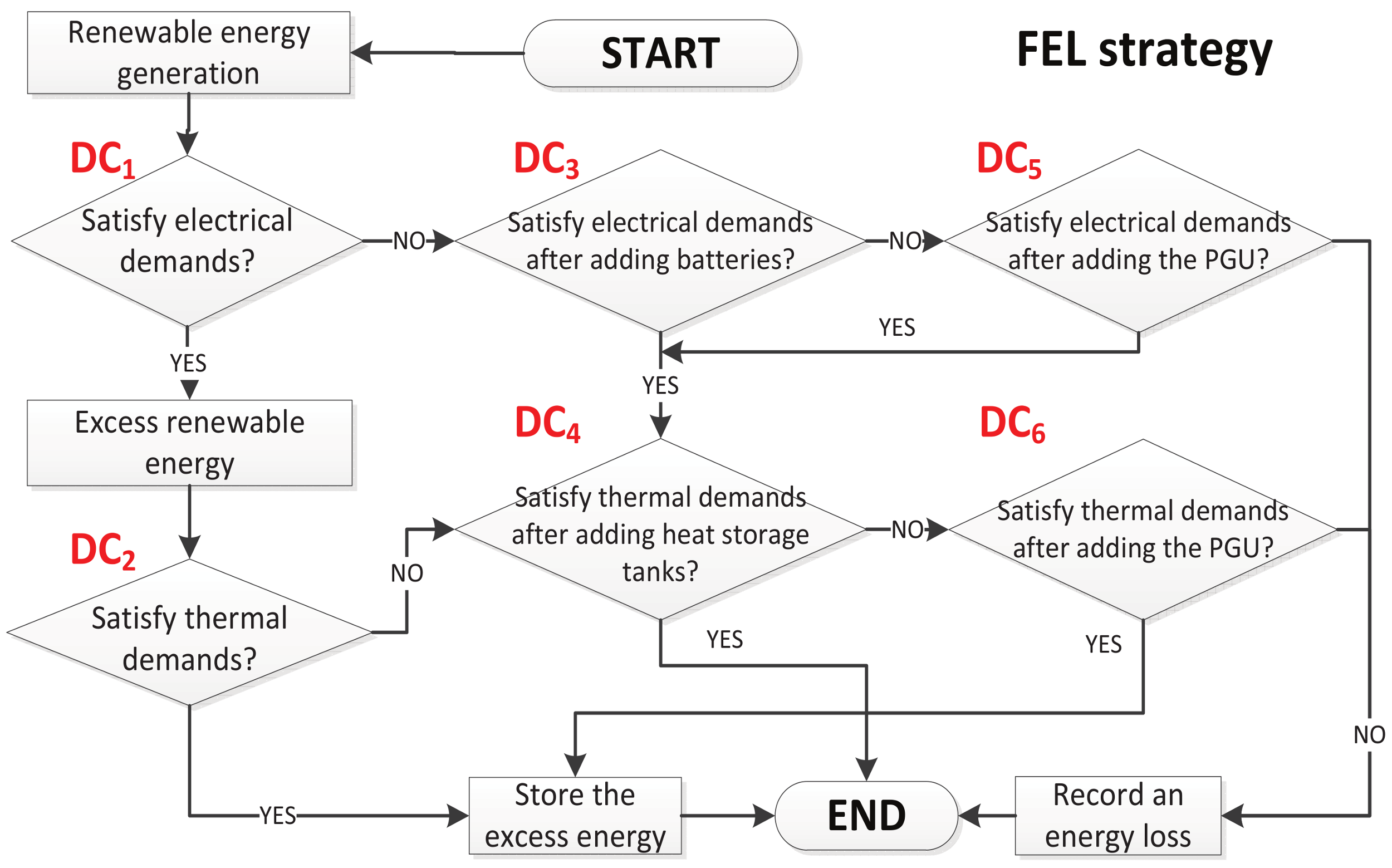
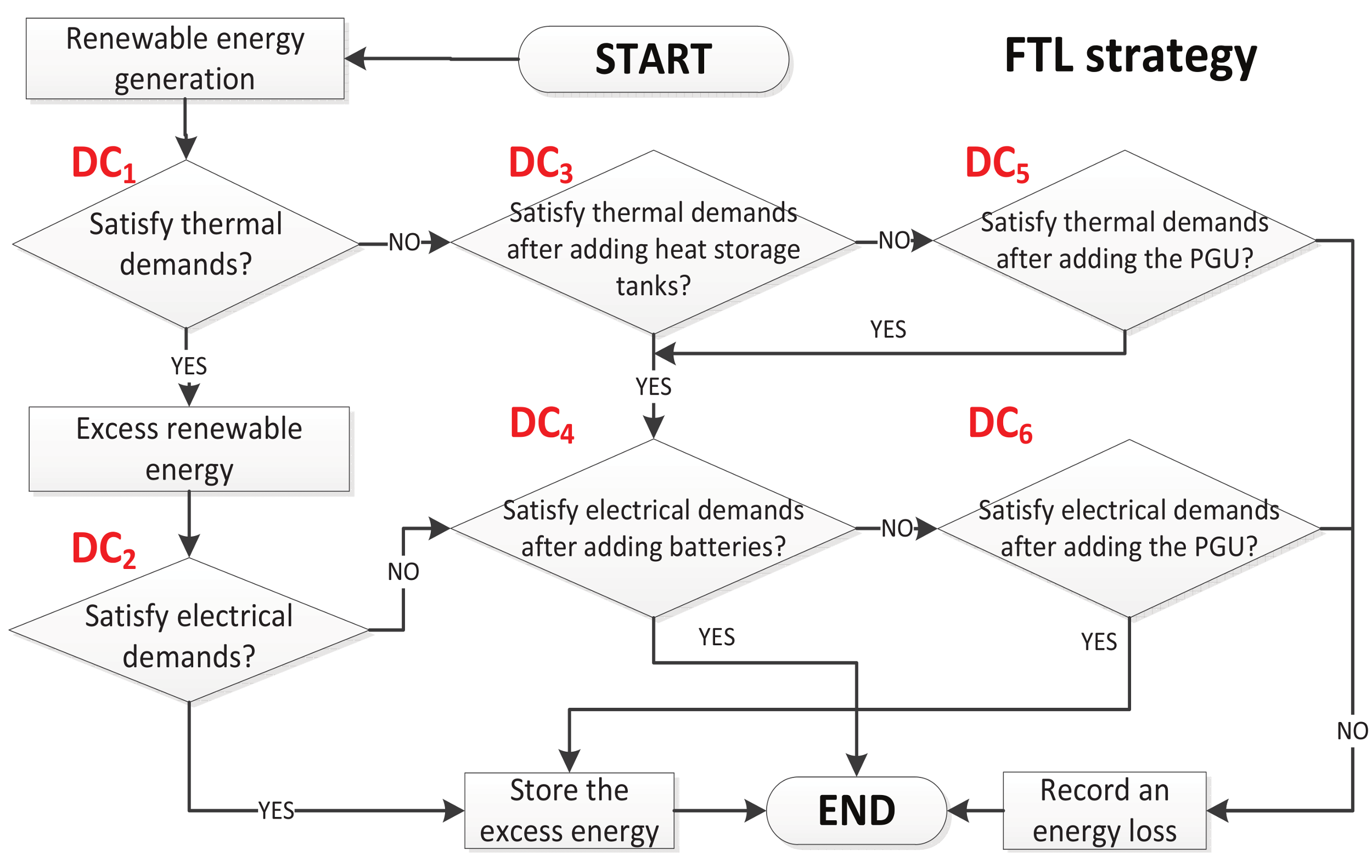
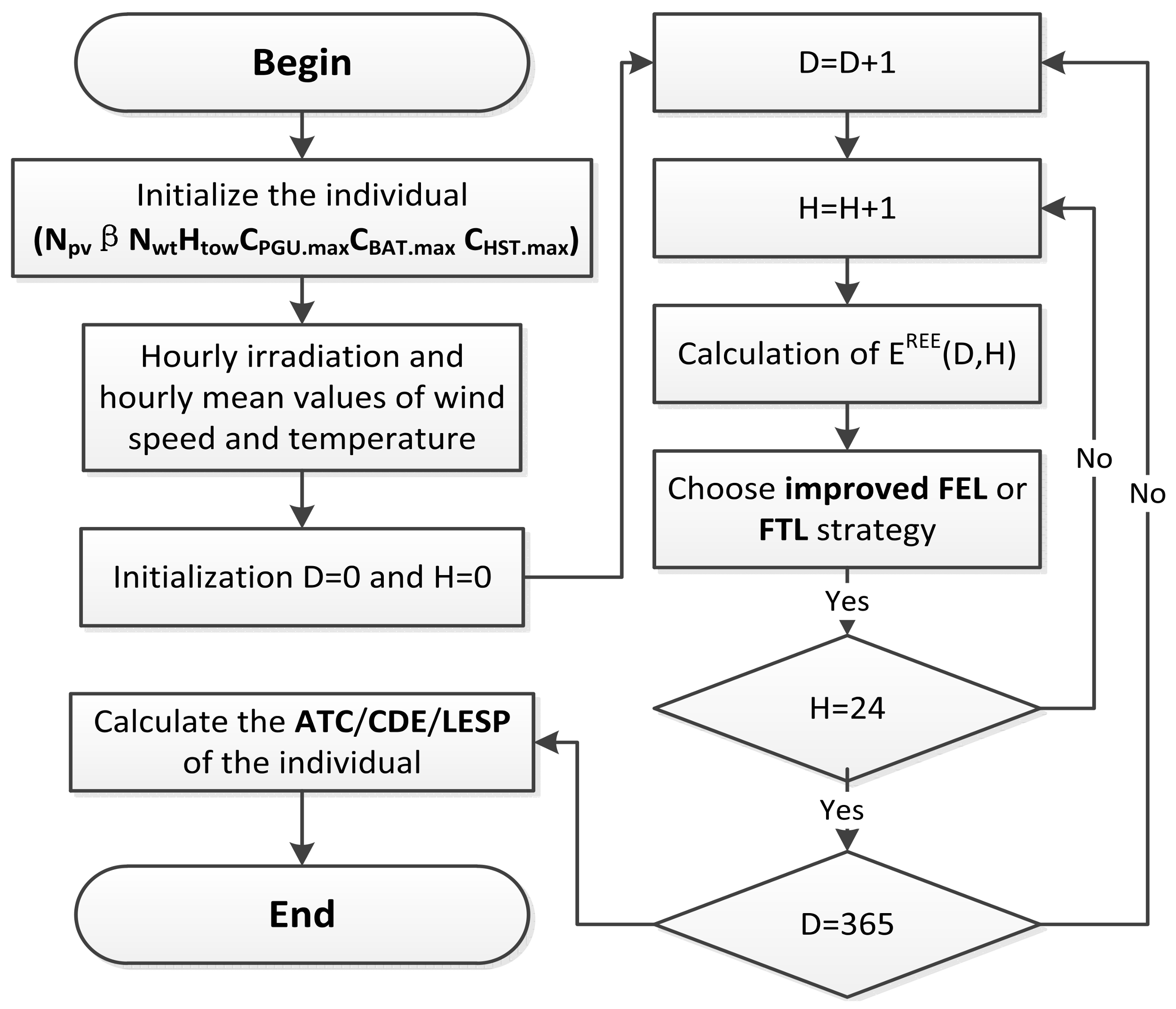
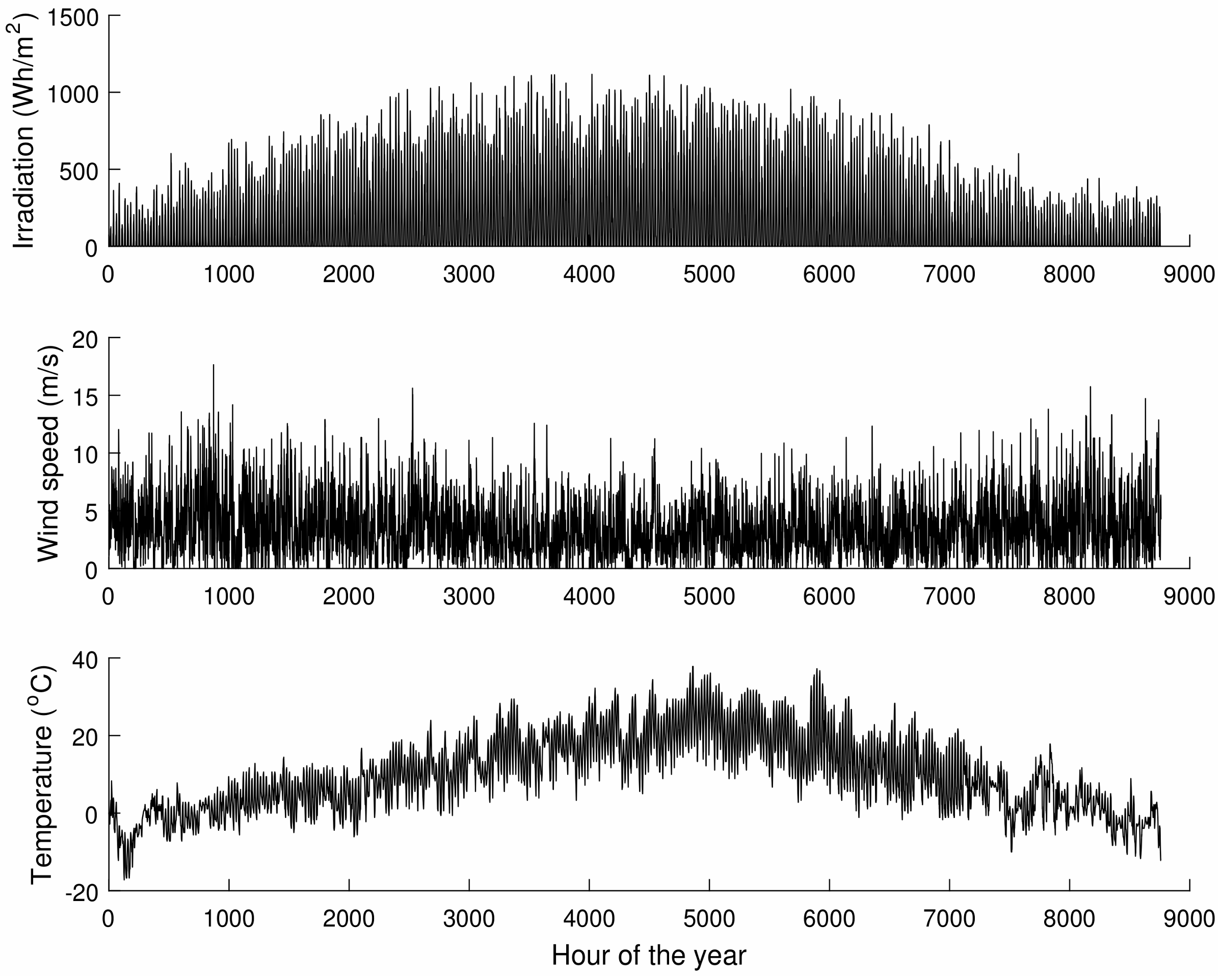
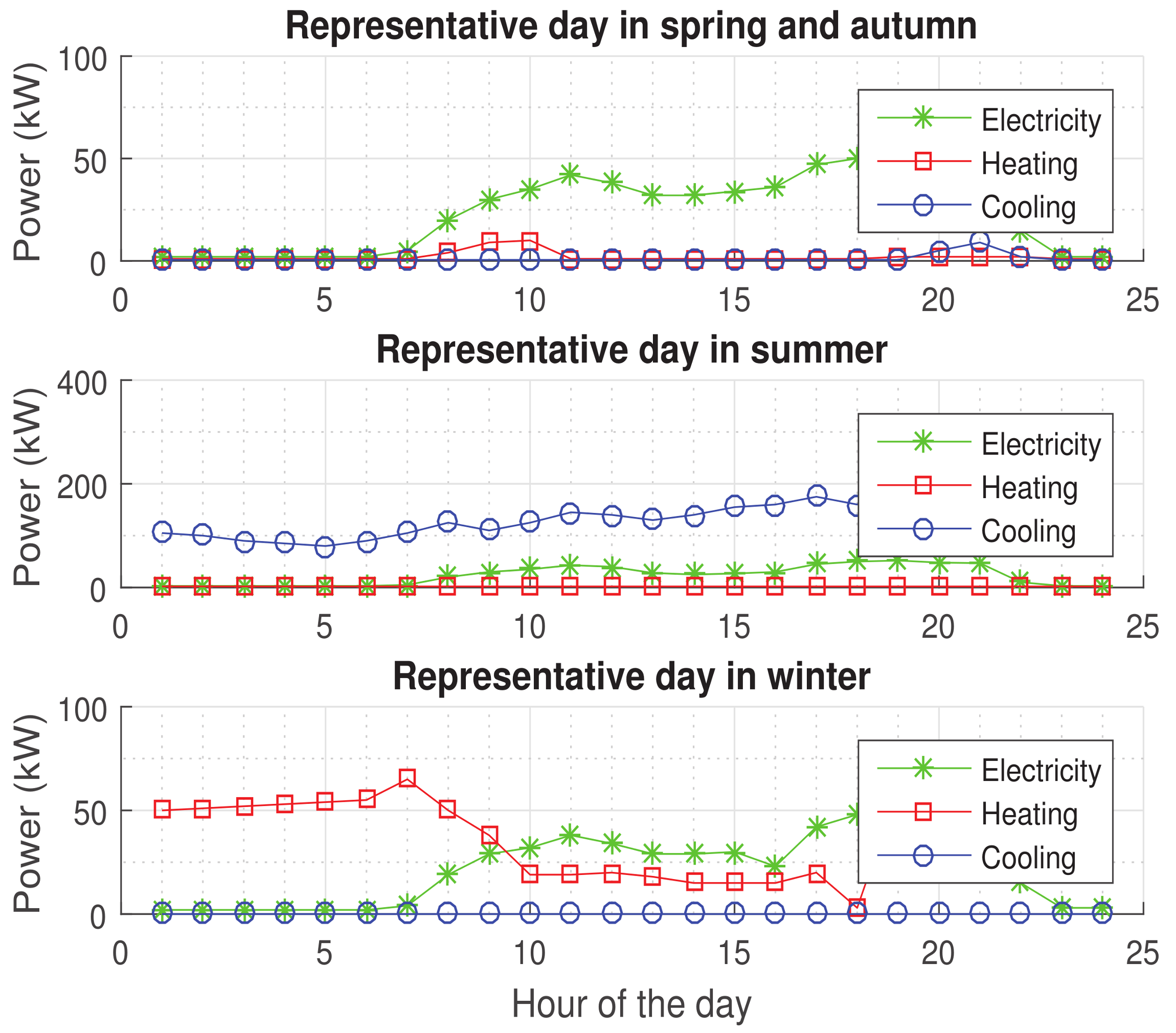
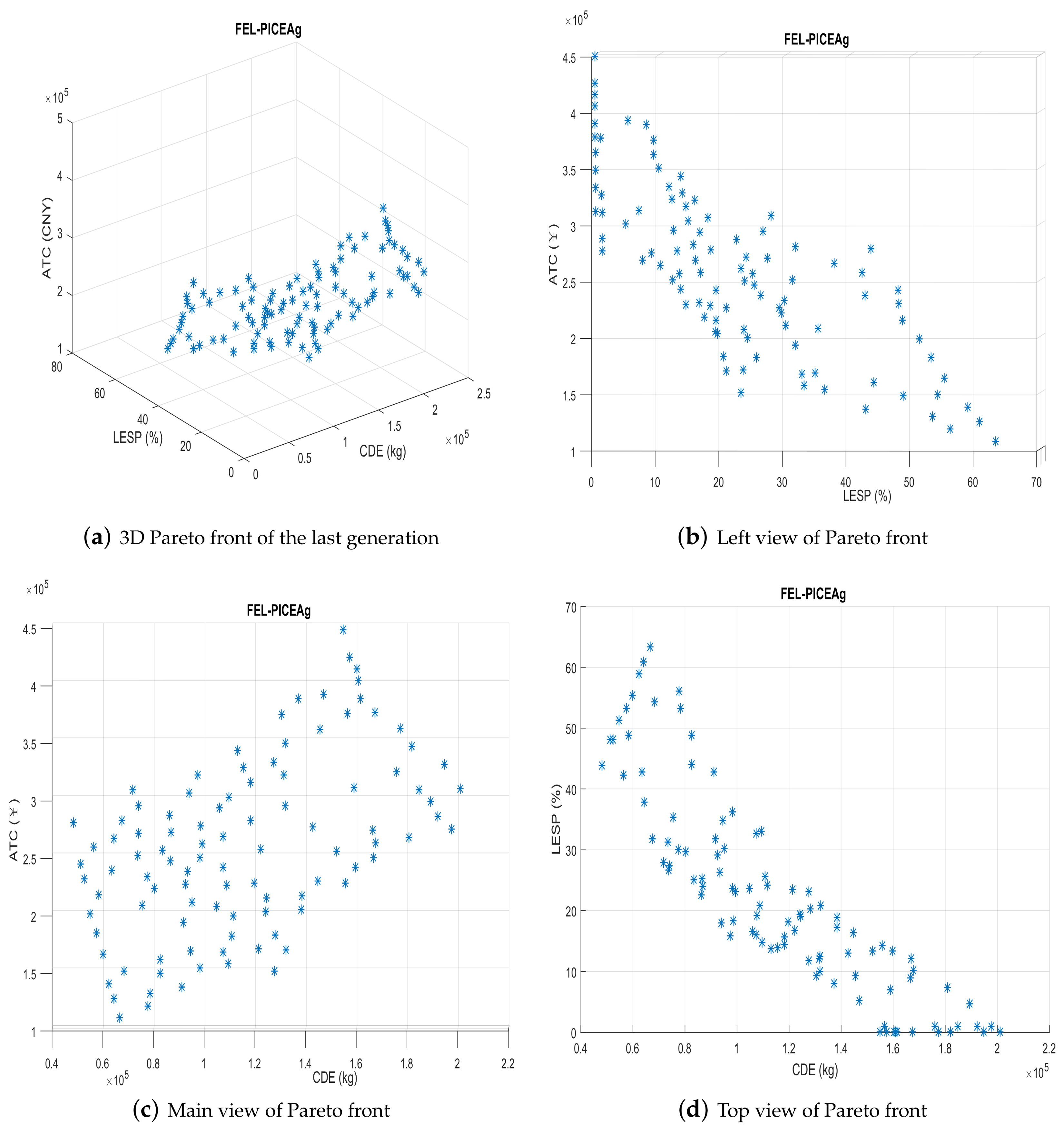
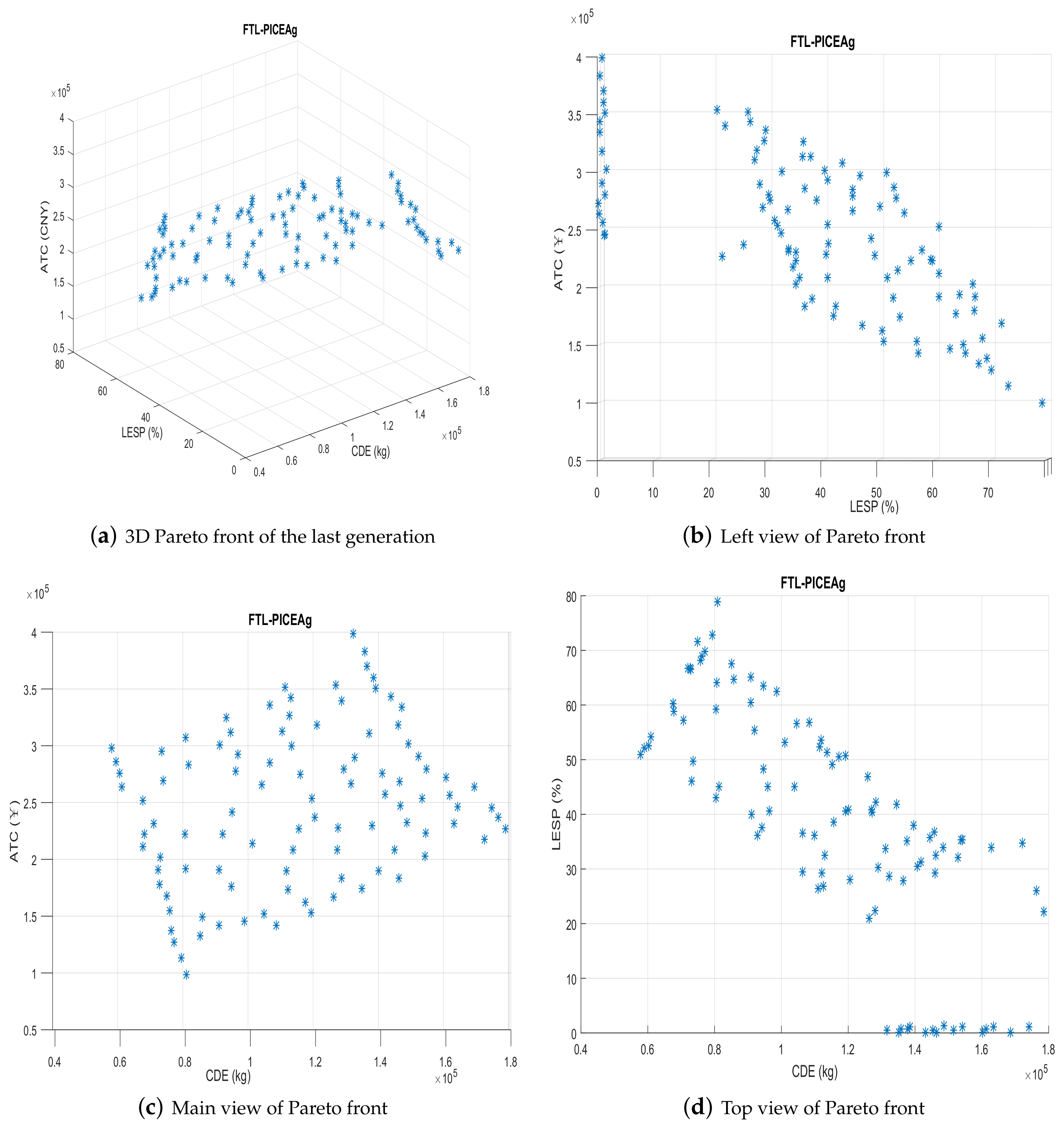
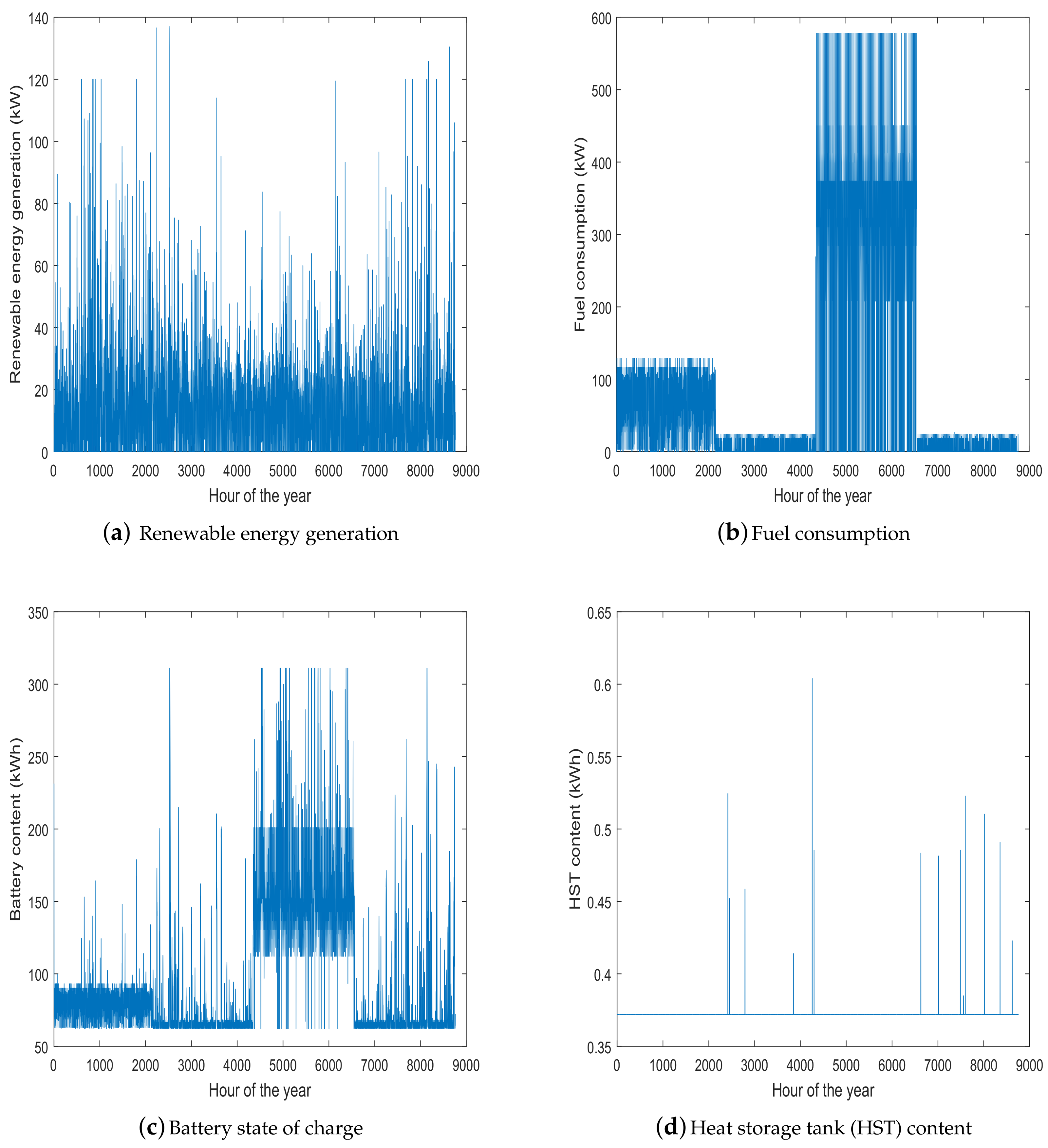
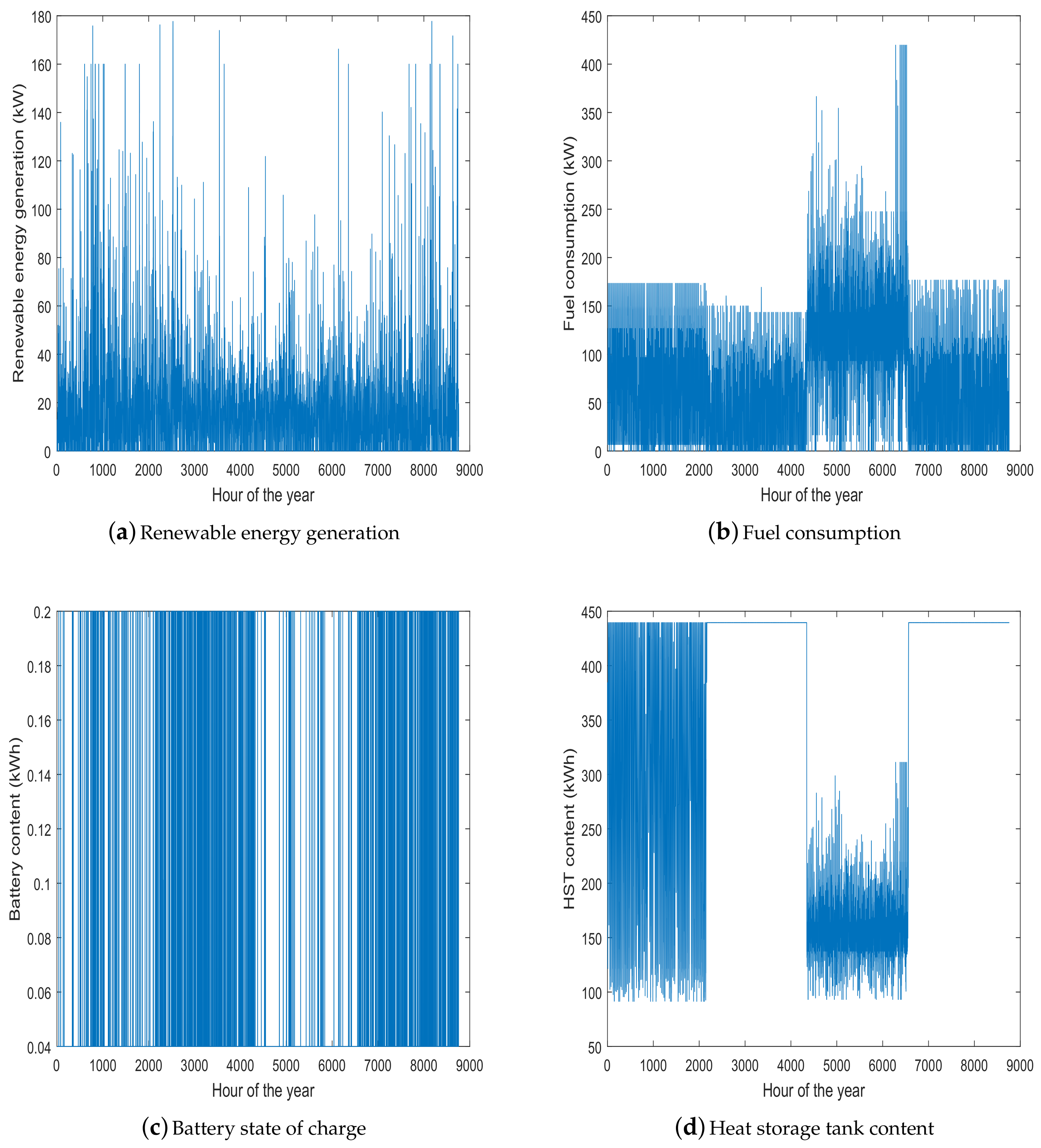
| Components | Lifetime (year) | & | ||
|---|---|---|---|---|
| PV panel | 1000 CNY | 0.05 CNY/h | 15 | 0.73 |
| Wind turbine | 30,000 CNY | 0.4 CNY/h | 15 | 0.4 |
| Wind tower | 2000 CNY/m | 0.1 CNY/m | 15 | Null |
| Battery | 200 CNY/kW | 0.2 CNY/kW·h | 5 | 0.8/0.8 (ch/dis) |
| Heat storage tank | 200 CNY/kW | 0.2 CNY/kW·h | 5 | 0.85/0.85 (in/out) |
| Electric boiler | 5500 CNY | 0.1 CNY/kW | 15 | 0.9 |
| Electric chiller | 9000 CNY | 0.1 CNY/kW | 15 | 3 |
| Absorption chiller | 64,000 CNY | 0.20 CNY/kW | 15 | 0.7 |
| Heating coil | 700 CNY | 0.24 CNY/kW | 15 | 0.9 |
| PGU | 3800 CNY/kW | 0.3 CNY/kW·h | 15 | 0.3 |
| Heat recovery system | 3000 CNY/kW | 0.2 CNY/kW·h | 15 | 0.8 |
| 4 m/s | 14 m/s | 20 m/s | 12.59 m2 | 10 kW | 10 m | 1.29 kg/m3 | 0.143 |
| NCOT | ||||||
|---|---|---|---|---|---|---|
| 7.22 A | 21 V | 17 | 6.47 | 0.95 | 0.95 | 43 °C |
| Parameter | Value | Parameter | Value |
|---|---|---|---|
| Population size | 100 | Mutation probability | 0.01 |
| Evolutionary generations | 100 | Position parameter (k) | 18 |
| Crossover probability | 0.9 | Distance parameter (l) | 14 |
| Length of genes | 7 | Decision variables () | 32 |
| FEL | ||||||||||
| Solution | (m) | (kW·h) | (kW·h) | (kW·h) | (CNY) | LESP(%) | (kg) | |||
| 1 (ATC.opt) | 19 | 59 | 19 | 29 | 650 | 145 | 2 | 1.55 | 0 | 4.49 |
| 2 | 20 | 40 | 13 | 23 | 612 | 274.5 | 2 | 1.62 | 0 | 3.89 |
| 3 | 19 | 48 | 12 | 18 | 620 | 311 | 1.9 | 1.68 | 0 | 3.77 |
| FTL | ||||||||||
| 1 (ATC.opt) | 20 | 59 | 16 | 25 | 489.7 | 0.2 | 439.5 | 1.35 | 0 | 3.83 |
| 2 | 20 | 56 | 17 | 10 | 468.6 | 0 | 321 | 1.43 | 0.1 | 3.43 |
| 3 | 20 | 59 | 17 | 6 | 474.4 | 0.003 | 327 | 1.46 | 0.1 | 3.34 |
© 2018 by the authors. Licensee MDPI, Basel, Switzerland. This article is an open access article distributed under the terms and conditions of the Creative Commons Attribution (CC BY) license (http://creativecommons.org/licenses/by/4.0/).
Share and Cite
Li, G.; Wang, R.; Zhang, T.; Ming, M. Multi-Objective Optimal Design of Renewable Energy Integrated CCHP System Using PICEA-g. Energies 2018, 11, 743. https://doi.org/10.3390/en11040743
Li G, Wang R, Zhang T, Ming M. Multi-Objective Optimal Design of Renewable Energy Integrated CCHP System Using PICEA-g. Energies. 2018; 11(4):743. https://doi.org/10.3390/en11040743
Chicago/Turabian StyleLi, Guozheng, Rui Wang, Tao Zhang, and Mengjun Ming. 2018. "Multi-Objective Optimal Design of Renewable Energy Integrated CCHP System Using PICEA-g" Energies 11, no. 4: 743. https://doi.org/10.3390/en11040743




